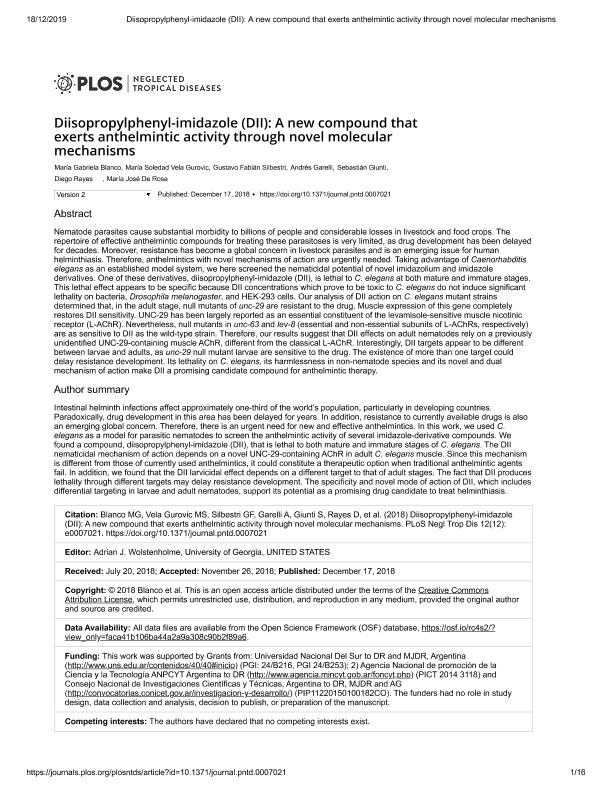Mostrar el registro sencillo del ítem
dc.contributor.author
Blanco, Maria Gabriela

dc.contributor.author
Vela Gurovic, Maria Soledad

dc.contributor.author
Silbestri, Gustavo Fabián

dc.contributor.author
Garelli, Andres

dc.contributor.author
Giunti, Sebastián

dc.contributor.author
Rayes, Diego Hernán

dc.contributor.author
de Rosa, Maria Jose

dc.date.available
2019-12-18T16:26:23Z
dc.date.issued
2018-12
dc.identifier.citation
Blanco, Maria Gabriela; Vela Gurovic, Maria Soledad; Silbestri, Gustavo Fabián; Garelli, Andres; Giunti, Sebastián; et al.; Diisopropylphenyl-imidazole (DII): A new compound that exerts anthelmintic activity through novel molecular mechanisms; Public Library of Science; PLoS Neglected Tropical Diseases; 12; 12; 12-2018
dc.identifier.issn
1935-2735
dc.identifier.uri
http://hdl.handle.net/11336/92485
dc.description.abstract
Nematode parasites cause substantial morbidity to billions of people and considerable losses in livestock and food crops. The repertoire of effective anthelmintic compounds for treating these parasitoses is very limited, as drug development has been delayed for decades. Moreover, resistance has become a global concern in livestock parasites and is an emerging issue for human helminthiasis. Therefore, anthelmintics with novel mechanisms of action are urgently needed. Taking advantage of Caenorhabditis elegans as an established model system, we here screened the nematicidal potential of novel imidazolium and imidazole derivatives. One of these derivatives, diisopropylphenyl-imidazole (DII), is lethal to C. elegans at both mature and immature stages. This lethal effect appears to be specific because DII concentrations which prove to be toxic to C. elegans do not induce significant lethality on bacteria, Drosophila melanogaster, and HEK-293 cells. Our analysis of DII action on C. elegans mutant strains determined that, in the adult stage, null mutants of unc-29 are resistant to the drug. Muscle expression of this gene completely restores DII sensitivity. UNC-29 has been largely reported as an essential constituent of the levamisole-sensitive muscle nicotinic receptor (L-AChR). Nevertheless, null mutants in unc-63 and lev-8 (essential and non-essential subunits of L-AChRs, respectively) are as sensitive to DII as the wild-type strain. Therefore, our results suggest that DII effects on adult nematodes rely on a previously unidentified UNC-29-containing muscle AChR, different from the classical L-AChR. Interestingly, DII targets appear to be different between larvae and adults, as unc-29 null mutant larvae are sensitive to the drug. The existence of more than one target could delay resistance development. Its lethality on C. elegans, its harmlessness in non-nematode species and its novel and dual mechanism of action make DII a promising candidate compound for anthelmintic therapy.
dc.format
application/pdf
dc.language.iso
eng
dc.publisher
Public Library of Science

dc.rights
info:eu-repo/semantics/openAccess
dc.rights.uri
https://creativecommons.org/licenses/by/2.5/ar/
dc.subject
Anthelmintic
dc.subject
C. elegans
dc.subject
Imidazole
dc.subject
Nematode
dc.subject.classification
Biología Celular, Microbiología

dc.subject.classification
Ciencias Biológicas

dc.subject.classification
CIENCIAS NATURALES Y EXACTAS

dc.title
Diisopropylphenyl-imidazole (DII): A new compound that exerts anthelmintic activity through novel molecular mechanisms
dc.type
info:eu-repo/semantics/article
dc.type
info:ar-repo/semantics/artículo
dc.type
info:eu-repo/semantics/publishedVersion
dc.date.updated
2019-10-22T17:31:49Z
dc.journal.volume
12
dc.journal.number
12
dc.journal.pais
Estados Unidos

dc.journal.ciudad
San Francisco
dc.description.fil
Fil: Blanco, Maria Gabriela. Universidad Nacional del Sur. Departamento de Biología, Bioquímica y Farmacia; Argentina. Consejo Nacional de Investigaciones Científicas y Técnicas. Centro Científico Tecnológico Conicet - Bahía Blanca. Instituto de Investigaciones Bioquímicas de Bahía Blanca. Universidad Nacional del Sur. Instituto de Investigaciones Bioquímicas de Bahía Blanca; Argentina
dc.description.fil
Fil: Vela Gurovic, Maria Soledad. Consejo Nacional de Investigaciones Científicas y Técnicas. Centro Científico Tecnológico Conicet - Bahía Blanca. Centro de Recursos Naturales Renovables de la Zona Semiárida. Universidad Nacional del Sur. Centro de Recursos Naturales Renovables de la Zona Semiárida; Argentina. Universidad Nacional del Sur. Departamento de Biología, Bioquímica y Farmacia; Argentina
dc.description.fil
Fil: Silbestri, Gustavo Fabián. Consejo Nacional de Investigaciones Científicas y Técnicas. Centro Científico Tecnológico Conicet - Bahía Blanca. Instituto de Química del Sur. Universidad Nacional del Sur. Departamento de Química. Instituto de Química del Sur; Argentina
dc.description.fil
Fil: Garelli, Andres. Universidad Nacional del Sur. Departamento de Biología, Bioquímica y Farmacia; Argentina. Consejo Nacional de Investigaciones Científicas y Técnicas. Centro Científico Tecnológico Conicet - Bahía Blanca. Instituto de Investigaciones Bioquímicas de Bahía Blanca. Universidad Nacional del Sur. Instituto de Investigaciones Bioquímicas de Bahía Blanca; Argentina
dc.description.fil
Fil: Giunti, Sebastián. Universidad Nacional del Sur. Departamento de Biología, Bioquímica y Farmacia; Argentina. Consejo Nacional de Investigaciones Científicas y Técnicas. Centro Científico Tecnológico Conicet - Bahía Blanca. Instituto de Investigaciones Bioquímicas de Bahía Blanca. Universidad Nacional del Sur. Instituto de Investigaciones Bioquímicas de Bahía Blanca; Argentina
dc.description.fil
Fil: Rayes, Diego Hernán. Universidad Nacional del Sur. Departamento de Biología, Bioquímica y Farmacia; Argentina. Consejo Nacional de Investigaciones Científicas y Técnicas. Centro Científico Tecnológico Conicet - Bahía Blanca. Instituto de Investigaciones Bioquímicas de Bahía Blanca. Universidad Nacional del Sur. Instituto de Investigaciones Bioquímicas de Bahía Blanca; Argentina
dc.description.fil
Fil: de Rosa, Maria Jose. Universidad Nacional del Sur. Departamento de Biología, Bioquímica y Farmacia; Argentina. Consejo Nacional de Investigaciones Científicas y Técnicas. Centro Científico Tecnológico Conicet - Bahía Blanca. Instituto de Investigaciones Bioquímicas de Bahía Blanca. Universidad Nacional del Sur. Instituto de Investigaciones Bioquímicas de Bahía Blanca; Argentina
dc.journal.title
PLoS Neglected Tropical Diseases

dc.relation.alternativeid
info:eu-repo/semantics/altIdentifier/url/http://dx.plos.org/10.1371/journal.pntd.0007021
dc.relation.alternativeid
info:eu-repo/semantics/altIdentifier/doi/http://dx.doi.org/10.1371/journal.pntd.0007021
Archivos asociados
